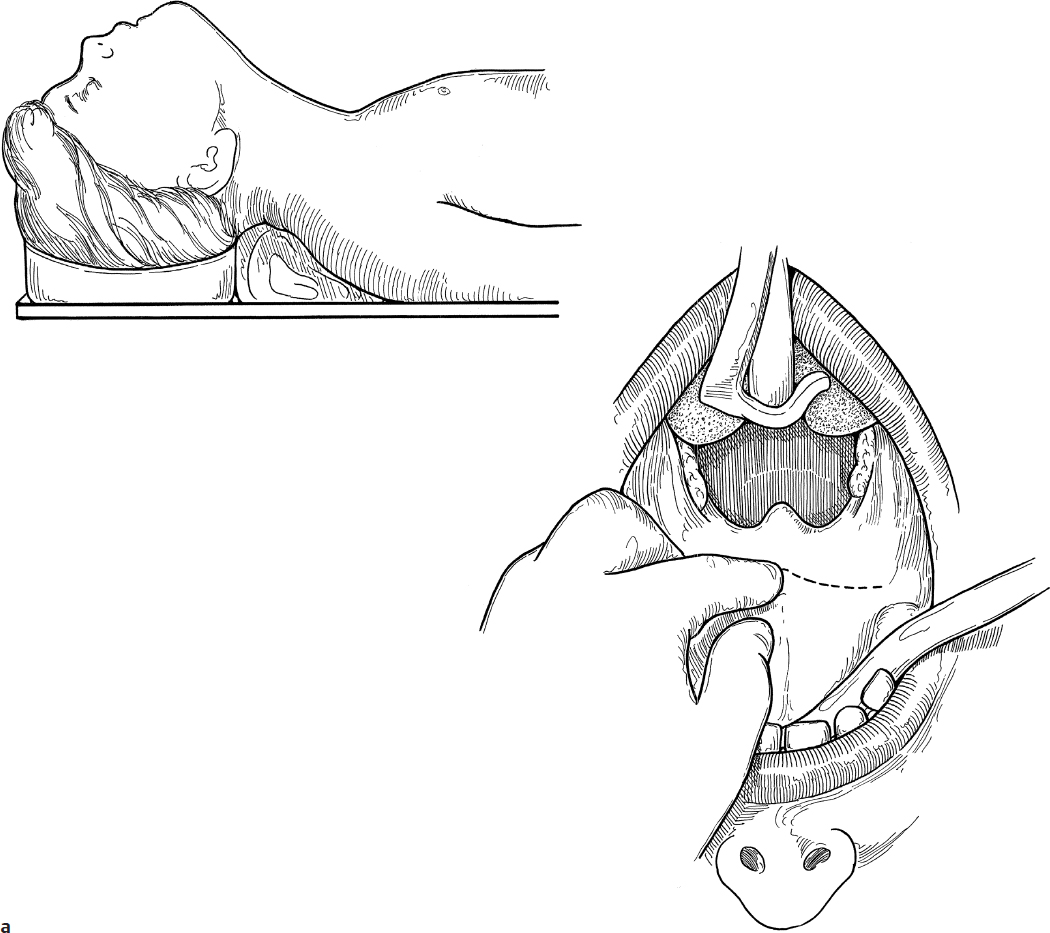Adenoids
Adenoid tissue may enlarge (hyperplasia) and/or become infected during bouts of pharyngitis. Adenoids can be removed with curettes, suction cautery, coblation, or a microdebrider.
18-1 Adenoidectomy with a Curette
Indications
Adenoidectomy is indicated for the relief of nasal obstruction, sleep apnea, recurrence of chronic infection, and as part of the surgical therapy of chronic ear disease.
Preoperative Evaluation
A lateral X-ray of the neck and nasoendoscopy are two reliable methods of assessing adenoid size. Careful evaluation of the palate to detect a submucous cleft palate or occult submucous cleft palate is necessary to minimize the incidence of velopharyngeal insufficiency (VPI) after adenoidectomy. The classic triad of a submucous cleft palate can be seen with careful inspection of the palate: (1) the abnormal insertion of levator palatine muscle; (2) a zona pellucida; and (3) a notch in the posterior border of the palate instead of the posterior nasal spine felt on palpation. The occult (or hidden) submucous cleft palate can only be determined by nasoendoscopy. Nasoendoscopy is not required in all cases planned for adenoidectomy.
Operative Technique
1. Adenoidectomy is performed under general anesthesia administered through an oral RAE tube. The patient is placed in the Rose position as for a tonsillectomy (see Section 19-1, Fig. 19.1a). A Crowe-Davis mouth gag or Dingman retractor is inserted and suspended onto a Mayo stand. Care is taken not to overextend the neck in patients suspected of having cervical spine abnormality. It is suggested that no shoulder roll be used in a patient with possible C-spine abnormalities and that the mouth gag be supported on the anterior chest wall of the patient with a small roll of towels such that the neck remains in neutral anatomical position.
2. The hard palate is carefully palpated to exclude the presence of a submucous cleft palate (Fig. 18.1a).
3. One or two red rubber catheters are placed through the nose to retract the palate (Fig. 18.1b). Alternately, if a latex-free environment is preferred, a 10-Fr suction catheter can be used.
4. A mirror is used to inspect the nasopharynx (Fig. 18.1c). It is important to visually inspect and palpate the posterior wall of the nasopharynx for any signs of abnormal arterial pulsation. A variety of arterial malformations, including severe tortuosity of the internal carotid artery, can occur in the nasopharynx.
5. Using the mirror for visualization, a sharp curette of suitable width is placed at the base of the vomer under direct vision (Fig. 18.1d).
6. The mirror is removed, and using the thumb as a fulcrum (Fig. 18.1e), the adenoid tissue is carefully removed in one slow, gentle sweep of the curette. Any residual adenoid tissue in the posterior choanae is removed using a small angled curette, again placed under direct vision (Fig. 18.1f). Alternatively, the entire adenoid can be removed with a suction cautery.
7. If curette is used, the nasopharynx is packed for a minimum of 2 minutes before suction cautery is used to cauterize any persistent bleeding vessels and to remove any residual adenoid tissue (Fig. 18.1g).
8. It is important to remove as much of the superior adenoid tissue as possible. Residual adenoid tissue often makes it difficult to obtain adequate hemostasis and may lead to regrowth of the adenoid and recurrence of nasopharyngeal obstruction. Care should be taken in removing the adenoid tissue surrounding the eustachian tube for fear of causing scarring at the end of the tube or nasopharyngeal stenosis.
9. It is also important to leave an inferior rim of adenoid tissue in place at the level of Passavant’s ridge to decrease the risk of postoperative VPI (Fig. 18.1h). If there is evidence of a submucous cleft palate, only the superior half of the adenoids should be removed.
Complications
1. Postoperative hemorrhage
2. Adenoid regrowth
3. VPI
4. Pharyngeal stenosis




